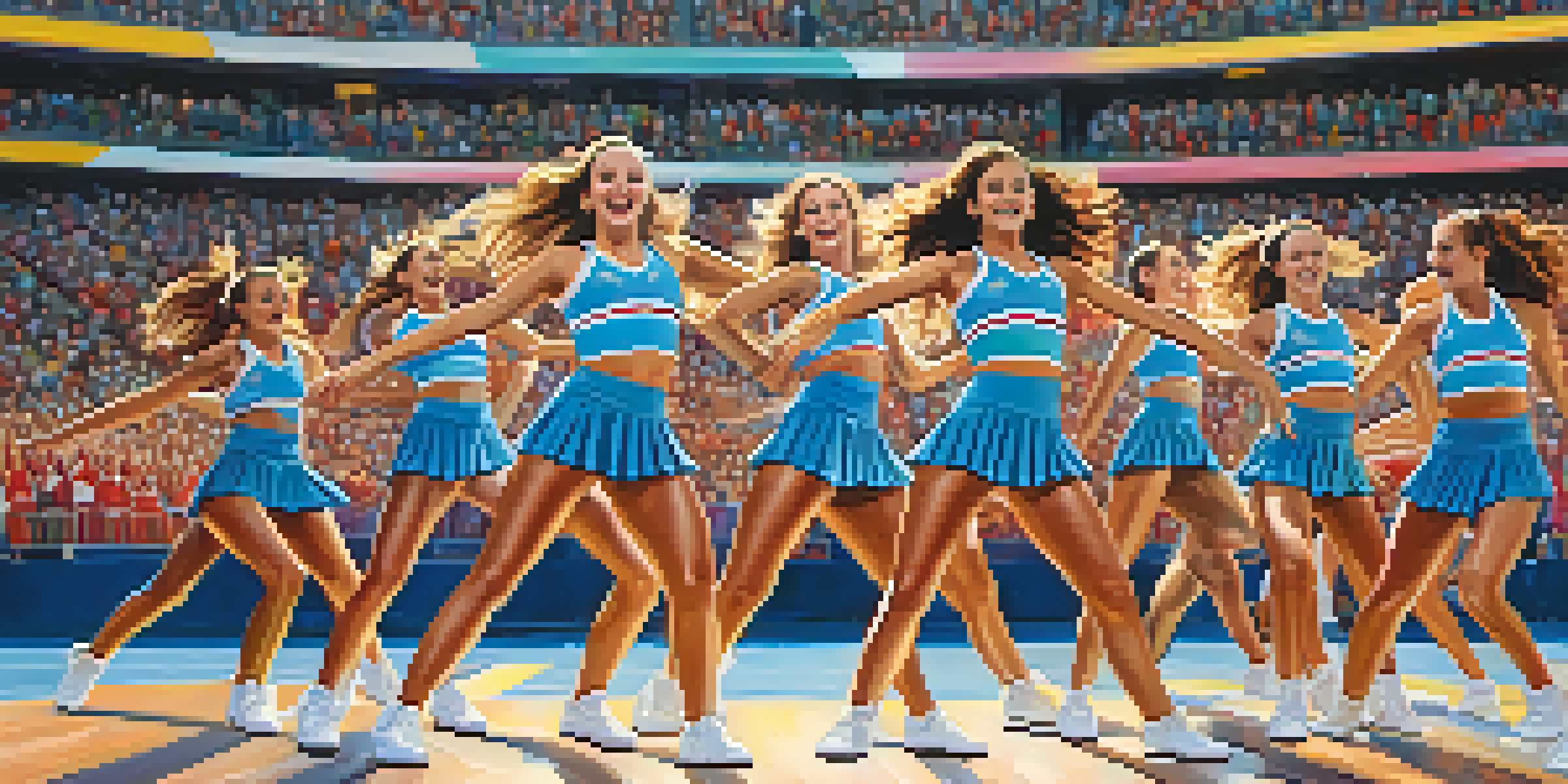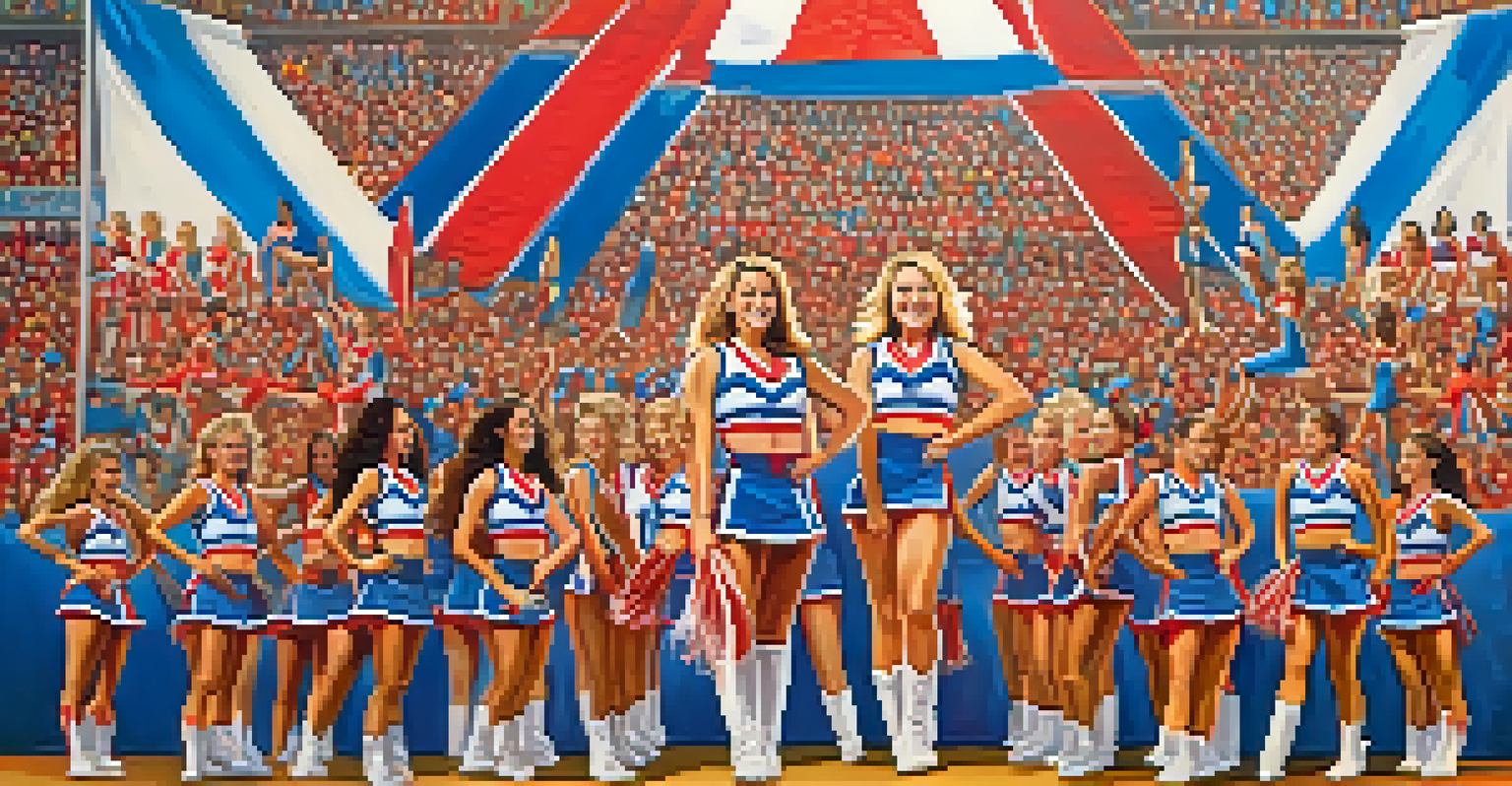Cheerleading: The Dance Form Elevating Sports Entertainment

The Evolution of Cheerleading: More Than Just Cheers
Cheerleading has come a long way from its origins in the late 19th century, where it started as a male-dominated activity focused primarily on leading crowds in cheers. Today, it encompasses a dynamic blend of dance, gymnastics, and acrobatics, making it a thrilling spectacle. These days, cheerleaders not only support sports teams but also engage audiences with intricate routines that require incredible skill and teamwork.
Cheerleading is a sport, and like all sports, it requires not just physical strength but also mental toughness and teamwork.
As the years have progressed, cheerleading has gained recognition as a competitive sport in its own right. High-energy performances at competitions showcase not only the athletic prowess of cheerleaders but also their creativity and artistry. This transformation has attracted a diverse group of participants, all eager to express themselves through this exhilarating dance form.
The evolution of cheerleading reflects broader cultural shifts, where female empowerment and athleticism have taken center stage. As more people recognize cheerleading's merit, it continues to grow, attracting new talent and elevating its status in the realm of sports entertainment.
The Athleticism Behind Cheerleading Routines
Cheerleading is often mistaken for mere sideline entertainment, but the athletic demands of this activity are immense. Cheerleaders undergo rigorous training to master skills like stunts, tumbling, and jumps, which require strength, flexibility, and coordination. Each routine is choreographed to perfection, demanding not only physical fitness but also mental focus to execute complex moves safely.

Consider a pyramid formation, where multiple cheerleaders balance on each other's shoulders. This requires not just physical strength but also trust and teamwork—one slip could lead to serious injuries. The precision involved in these routines is akin to a well-rehearsed dance performance, where every movement contributes to the overall impact.
Cheerleading's Athletic Evolution
Cheerleading has transformed from a sideline activity to a recognized competitive sport that showcases athleticism and teamwork.
Moreover, cheerleading promotes cardiovascular health, endurance, and muscle tone, making it a fantastic workout. When you see a cheerleader perform, you're witnessing years of dedication and hard work that go beyond just cheering for a sports team.
The Artistry of Cheerleading: Dance Meets Performance
At its core, cheerleading is an art form, combining dance with performance skills to create an engaging spectacle. Choreography plays a crucial role, as routines are designed to captivate audiences through rhythmic movements and expressive gestures. The blend of music, dance, and athleticism creates a unique form of entertainment that resonates with fans of all ages.
The power of cheerleading lies in its ability to bring people together, to uplift them, and to celebrate the spirit of community.
Each routine is carefully crafted to tell a story or convey an emotion, often reflecting the spirit of the team or event. The incorporation of various dance styles, from hip-hop to jazz, adds layers of complexity and flair. Cheerleaders not only perform but embody the essence of the teams they support.
This artistic element is what sets cheerleading apart from other sports activities. It invites creativity and self-expression, allowing cheerleaders to showcase their individual styles while working cohesively as a team.
Cheerleading Competitions: A Showcase of Talent
Cheerleading competitions are the ultimate proving ground for teams, showcasing their skills on a grand stage. Teams spend months perfecting their routines, which are judged based on criteria like difficulty, execution, and overall performance. These events not only highlight the athleticism and artistry of cheerleading but also foster a sense of camaraderie among participants.
One of the most prestigious competitions is the National Cheerleaders Association (NCA) Championship, where top teams from around the country compete for the title. Such events draw large crowds, amplifying the energy and excitement that cheerleading brings to the sports entertainment landscape.
Artistry in Cheerleading Routines
Cheerleading combines dance and performance to create captivating routines that reflect the spirit of the teams they support.
Furthermore, competitions encourage teams to innovate and push their limits, constantly evolving the sport. The drive for excellence in these settings elevates cheerleading, making it a thrilling spectacle for both participants and spectators alike.
The Role of Cheerleaders in Sports Culture
Cheerleaders play a vital role in enhancing the overall atmosphere of sporting events. They energize the crowd, rallying support for teams and creating an engaging environment that elevates the spectator experience. Their chants, cheers, and dance moves contribute to the emotional highs and lows of games, making them an integral part of the sports culture.
Moreover, cheerleaders often serve as ambassadors for their teams, participating in community events and charitable activities. This connection helps bridge the gap between the team and its fans, fostering loyalty and creating lasting relationships. It's not just about the game; it's about being part of something bigger.
This cultural significance is reflected in how cheerleaders are embraced by fans. Whether it's wearing team colors or sharing in the excitement of a victory, cheerleaders help cultivate a sense of belonging and pride among supporters.
The Impact of Cheerleading on Personal Development
Participating in cheerleading offers numerous benefits beyond physical fitness; it also plays a significant role in personal development. Cheerleaders often gain confidence, discipline, and leadership skills, all of which can be invaluable in various aspects of life. The experience of working as part of a team fosters communication skills and resilience, preparing individuals for future challenges.
Through practice and competition, cheerleaders learn the importance of commitment and hard work. Balancing cheerleading with academics or other responsibilities teaches time management skills that are essential in adulthood. The friendships formed on the cheer team can last a lifetime, providing a support network that encourages personal growth.
Personal Growth through Cheerleading
Participating in cheerleading fosters confidence, discipline, and leadership skills, contributing to personal development beyond the sport.
Ultimately, cheerleading is not just about the routines; it's about shaping well-rounded individuals who carry the lessons learned into their lives outside of the sport. This holistic development makes cheerleading an enriching experience for many.
The Future of Cheerleading: Trends and Innovations
As cheerleading continues to evolve, new trends and innovations are shaping its future. With the increasing popularity of social media, cheer teams are using platforms like TikTok and Instagram to showcase their skills and reach a broader audience. This digital presence is not only promoting cheerleading as a sport but also inspiring the next generation of cheerleaders.
Additionally, advancements in training techniques and safety measures are making cheerleading more accessible and safer for participants. Technology is being integrated into practice sessions, with tools like video analysis providing instant feedback to improve performance. This focus on safety is crucial, especially as stunts and routines become increasingly complex.

Looking ahead, the inclusion of cheerleading in more competitive arenas, such as the Olympics, could further elevate its status and recognition. As the sport gains more visibility, it opens doors for aspiring cheerleaders and highlights the dedication and talent within the community.